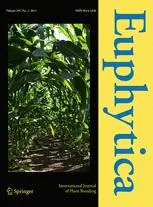Developing Cassava Mosaic Disease resistant cassava varieties in Ghana using a marker assisted selection approach

Abstract
Cassava is a major staple and food security crop in Africa which can produce a crop under uncertain rainfall and low fertility conditions. How- ever, it suffers from several pests and diseases, with Cassava Mosaic Disease (CMD) being the main biotic constraint in production in sub-Saharan Africa. It is caused by cassava mosaic geminiviruses. Plants infected with CMD usually produce a few or no storage roots. Markers associated with resistance genes to CMD have been mapped, including a major dominant gene, CMD2 . Eight CMD resistant geno- types from CIAT were used in crosses with three cassava landraces and one IITA breeding genotype. CMD evaluation was done on the parents and 525 F 1 progenies comprising of individuals pre-selected for CMD resistance based on average severity scores of 1 and 2. Multiple marker analysis was used to screen for the CMD2 gene, where four markers associated with this gene were used. Of the tested genotypes 83 % showed at least one marker allele for the CMD2 gene. Two CIAT genotypes (CR52A-31 and AR14-10) had all four marker alleles. TMEII had three alleles associated with CMD2 while Dabodabo had one marker allele. This suggests that Dababo may have alternative genes than CMD2 for CMD resistance. The F 1 families showed segregation for the CMD2 gene. A total of 88 individuals (17 %) had all four marker alleles associated with the CMD2 gene. A total of 179 individuals had between one to three marker alleles each associated with CMD2 . A total of 91 individuals had no marker allele associated with the CMD2 geneCassava is a major staple and food security crop in Africa which can produce a crop under uncertain rainfall and low fertility conditions. How- ever, it suffers from several pests and diseases, with Cassava Mosaic Disease (CMD) being the main biotic constraint in production in sub-Saharan Africa. It is caused by cassava mosaic geminiviruses. Plants infected with CMD usually produce a few or no storage roots. Markers associated with resistance genes to CMD have been mapped, including a major dominant gene, CMD2 . Eight CMD resistant geno- types from CIAT were used in crosses with three cassava landraces and one IITA breeding genotype. CMD evaluation was done on the parents and 525 F 1 progenies comprising of individuals pre-selected for CMD resistance based on average severity scores of 1 and 2. Multiple marker analysis was used to screen for the CMD2 gene, where four markers associated with this gene were used. Of the tested genotypes 83 % showed at least one marker allele for the CMD2 gene. Two CIAT genotypes (CR52A-31 and AR14-10) had all four marker alleles. TMEII had three alleles associated with CMD2 while Dabodabo had one marker allele. This suggests that Dababo may have alternative genes than CMD2 for CMD resistance. The F 1 families showed segregation for the CMD2 gene. A total of 88 individuals (17 %) had all four marker alleles associated with the CMD2 gene. A total of 179 individuals had between one to three marker alleles each associated with CMD2 . A total of 91 individuals had no marker allele associated with the CMD2 geneCassava is a major staple and food security crop in Africa which can produce a crop under uncertain rainfall and low fertility conditions. How- ever, it suffers from several pests and diseases, with Cassava Mosaic Disease (CMD) being the main biotic constraint in production in sub-Saharan Africa. It is caused by cassava mosaic geminiviruses. Plants infected with CMD usually produce a few or no storage roots. Markers associated with resistance genes to CMD have been mapped, including a major dominant gene, CMD2 . Eight CMD resistant geno- types from CIAT were used in crosses with three cassava landraces and one IITA breeding genotype. CMD evaluation was done on the parents and 525 F 1 progenies comprising of individuals pre-selected for CMD resistance based on average severity scores of 1 and 2. Multiple marker analysis was used to screen for the CMD2 gene, where four markers associated with this gene were used. Of the tested genotypes 83 % showed at least one marker allele for the CMD2 gene. Two CIAT genotypes (CR52A-31 and AR14-10) had all four marker alleles. TMEII had three alleles associated with CMD2 while Dabodabo had one marker allele. This suggests that Dababo may have alternative genes than CMD2 for CMD resistance. The F 1 families showed segregation for the CMD2 gene. A total of 88 individuals (17 %) had all four marker alleles associated with the CMD2 gene. A total of 179 individuals had between one to three marker alleles each associated with CMD2 . A total of 91 individuals had no marker allele associated with the CMD2 gene
